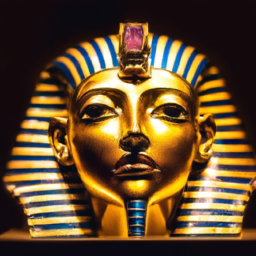The fascination with Tutankhamun, the young pharaoh of ancient Egypt, has endured for nearly a century since the discovery of his tomb in 1922. This tomb, located in the Valley of the Kings, was unearthed by British archaeologist Howard Carter and has since become a symbol of Egyptology and a source of endless intrigue. The artifacts found within the tomb, including the iconic golden mask, have captivated audiences worldwide, prompting many to explore the life and legacy of this enigmatic ruler. In my experience, the allure of Tutankhamun lies not only in the treasures that adorned his burial site but also in the mystery surrounding his life and reign. Despite ascending to the throne at a young age, around eight or nine, Tutankhamuns rule was marked by significant political and religious upheaval. His reign, which lasted from approximately 1332 to 1323 BCE, occurred during a transformative period in ancient Egyptian history, characterized by the shift from monotheistic worship of the sun god Aten back to the traditional polytheistic beliefs. Research shows that Tutankhamuns early death at around eighteen years old has led to much speculation regarding the circumstances surrounding his passing. Various theories have emerged, ranging from accidental injury to genetic disorders, as studies of his mummified remains indicate possible health issues. Experts agree that the young kings untimely demise has contributed to the enduring fascination with his story, as it raises questions about the fragility of power and the mysteries of life in ancient Egypt. The discovery of Tutankhamuns tomb was groundbreaking, not only for its wealth of artifacts but also for the insights it provided into ancient Egyptian burial practices. According to official reports from the Egyptian Antiquities Ministry, the tomb contained over 5,000 items, including jewelry, weapons, and everyday objects, all designed to accompany the pharaoh into the afterlife. This wealth of material culture has allowed archaeologists and historians to piece together aspects of daily life in ancient Egypt, revealing the societal norms and values of the time. In analyzing the significance of Tutankhamuns tomb, it is essential to consider the broader context of ancient Egyptian funerary practices. The elaborate burial customs were rooted in the belief in an afterlife, where the deceased would continue to exist in a different realm. This belief system necessitated the inclusion of various items in the tomb, which were thought to provide comfort and utility in the next life. The opulence of Tutankhamuns burial reflects not only his status as a king but also the cultural values of ancient Egyptian society, which placed immense importance on the afterlife. As observed, the impact of Tutankhamuns discovery extended far beyond the realm of archaeology. The 1920s saw a surge in public interest in ancient Egypt, often referred to as Egyptomania. This phenomenon was characterized by a fascination with Egyptian art, architecture, and culture, influencing fashion, design, and even cinema. The treasures of Tutankhamun toured the world, drawing millions of visitors and sparking a renewed interest in Egyptology. The legacy of this boy king has thus transcended academic circles, permeating popular culture and inspiring countless interpretations and representations. However, the legacy of Tutankhamun is not without its controversies. The excavation and subsequent exhibitions of his tomb artifacts have raised ethical questions regarding the treatment of cultural heritage. Critics argue that the removal of items from their original context can lead to a loss of cultural significance. Furthermore, ongoing debates about the repatriation of artifacts to Egypt highlight the complexities of ownership and cultural identity in the field of archaeology. These discussions underscore the need for a balanced perspective that considers both the educational value of exhibitions and the rights of source communities. Looking ahead, the continued study of Tutankhamun and his tomb promises to yield further insights into ancient Egyptian civilization. Advances in technology, such as non-invasive imaging techniques, allow researchers to explore the tomb and its contents without causing damage. These innovations may lead to new discoveries about the artifacts and the life of the young pharaoh, potentially reshaping our understanding of this pivotal figure in history. In conclusion, the story of Tutankhamun is one of intrigue, mystery, and cultural significance. His tomb serves as a window into the past, offering glimpses of a society that revered its leaders and believed in the power of the afterlife. As we continue to learn more about this boy king, we are reminded of the enduring impact of ancient Egypt on our collective imagination. The legacy of Tutankhamun is not merely confined to the artifacts of his tomb but extends to the ongoing dialogue about cultural heritage, identity, and the importance of preserving history for future generations.
Tutankhamun quiz: How much do you know about the famous boy king from ancient Egypt?

TRENDING NOW
WORLD
Global Messaging Trends: Can Local Apps Like Arattai Overtake Giants?
44% 🔥
POLITICS
Accusations fly over whether Republicans or Democrats 'own' shutdown
35% 🔥
POLITICS
Rep. Mike Haridopolos, R-Fla., talks about the government shutdown
34% 🔥
POLITICS
What happens now that the government has shut down. And, a pricing deal with Pfi...
26% 🔥
POLITICS
Married, but no connection: Reality of silent divorces in Indian homes
31% 🔥
POLITICS
Netanyahu's apology to Qatar, phone on Trump's lap: A telling White House photo
38% 🔥
MOST READ
SPORTS
Week 5 NFL odds, lines, betting picks, spreads: 2025 predictions: Model backs Sa...
55% 🔥
SPORTS
Predicting every undefeated college football team's first loss: Will anyone beat...
36% 🔥
SPORTS
Tigers Lefty Tarik Skubal Deserves Second Straight AL Cy Young Award
54% 🔥
SPORTS
Jets Get Official Braelon Allen Injury Diagnosis
61% 🔥
SPORTS
Gill: India won't be 'looking for any easy options' against West Indies
49% 🔥
SPORTS
Phil Mickelson takes a jibe at golf during friendly banter with ex-LIV Golf CEO’...
39% 🔥
